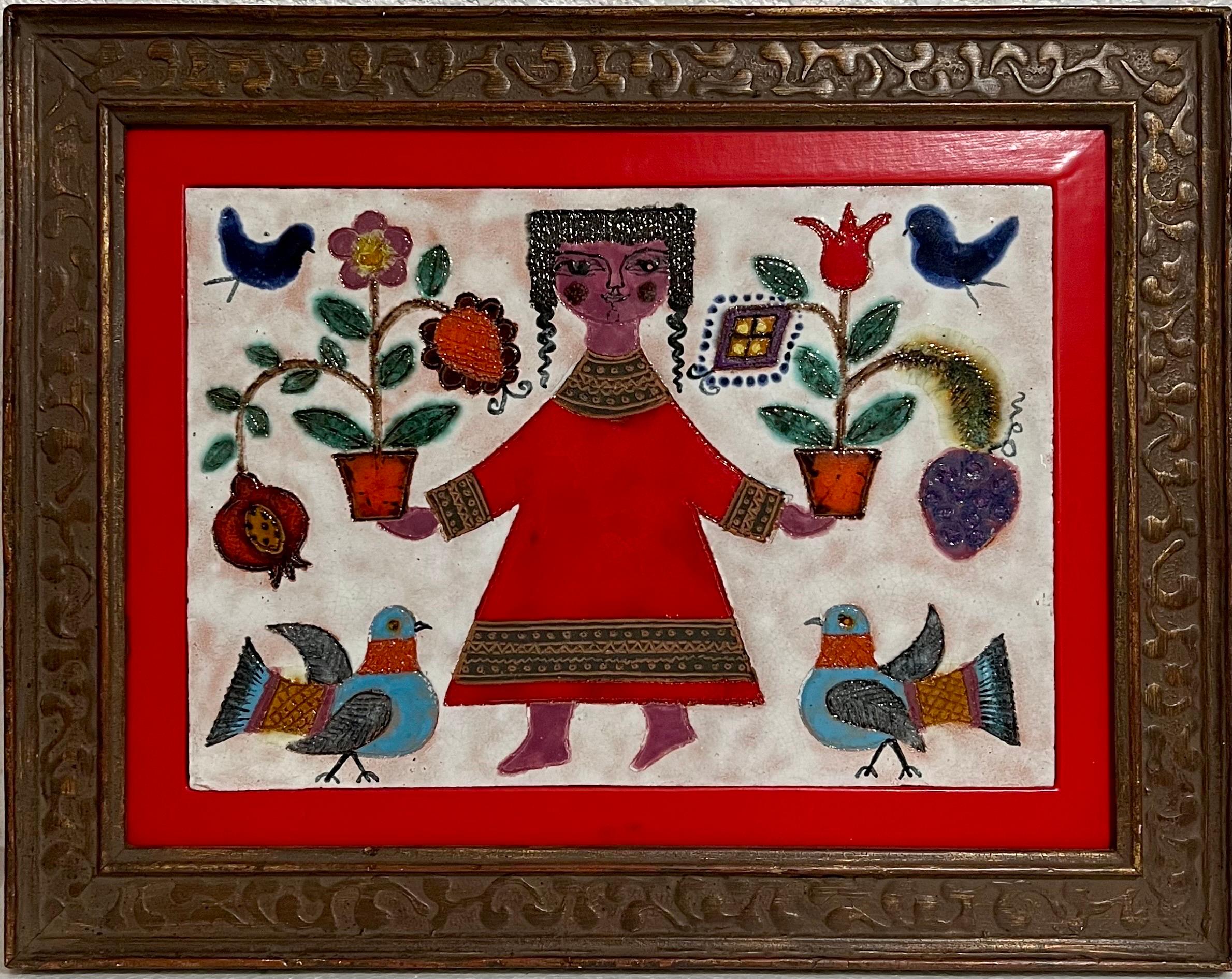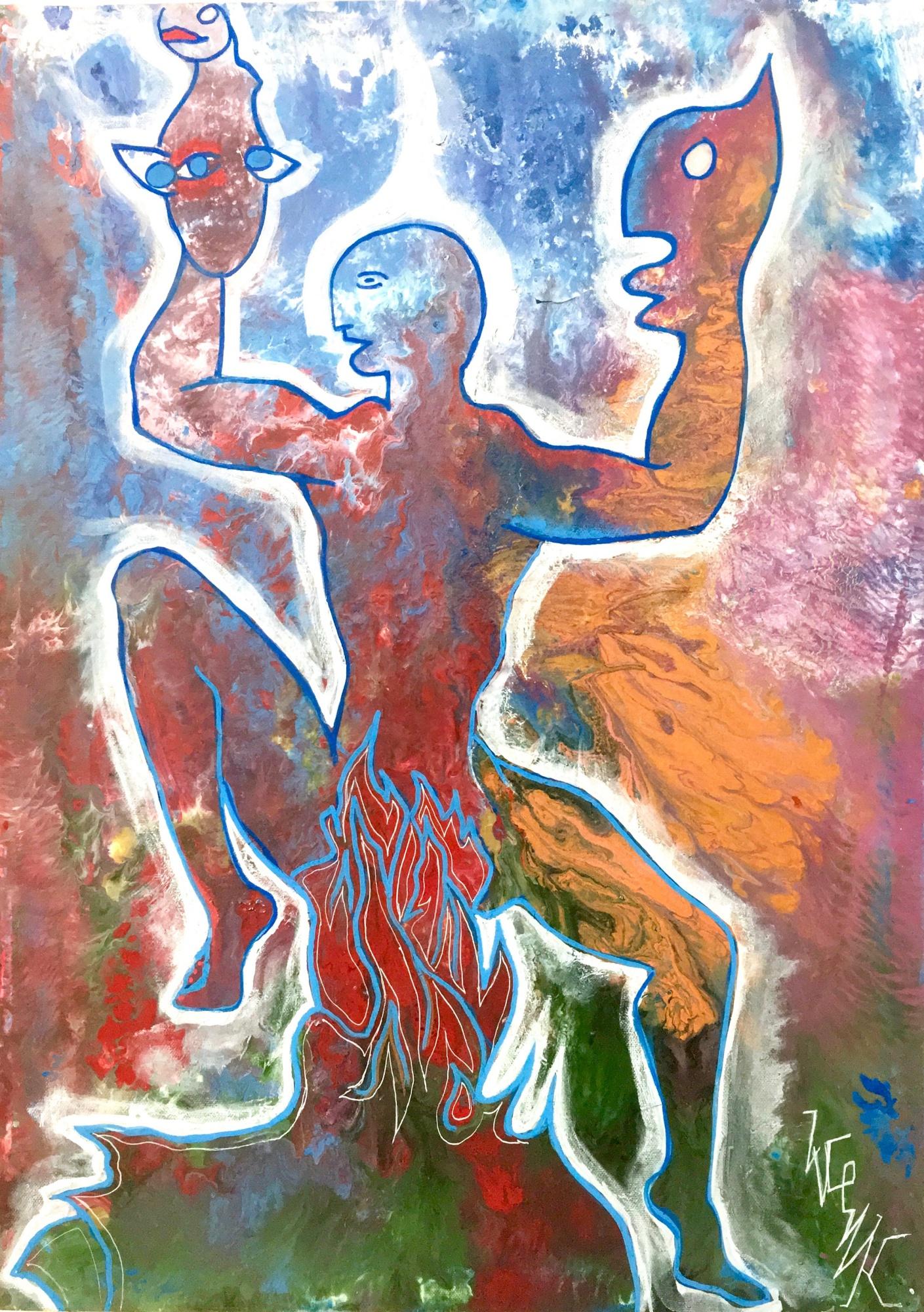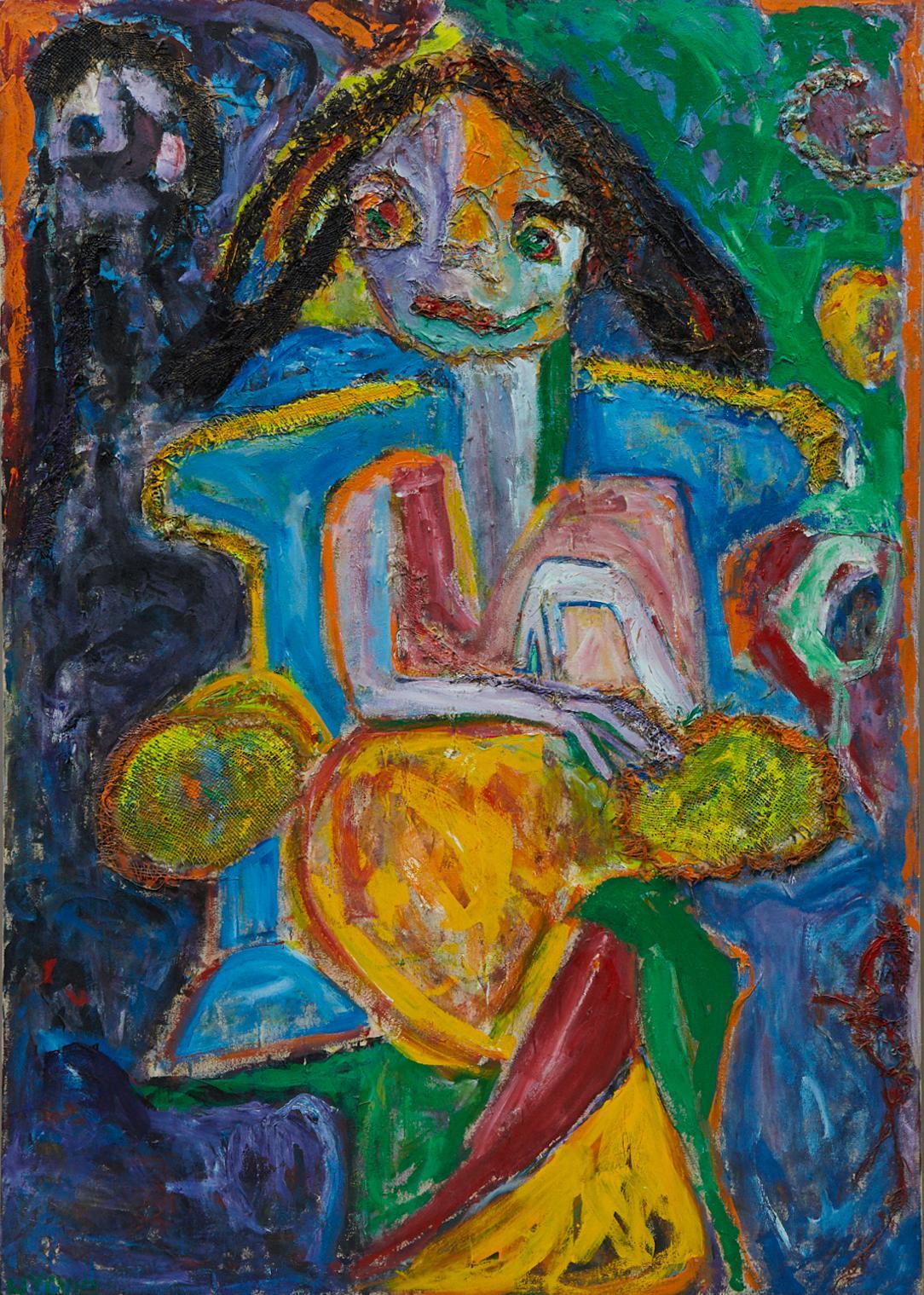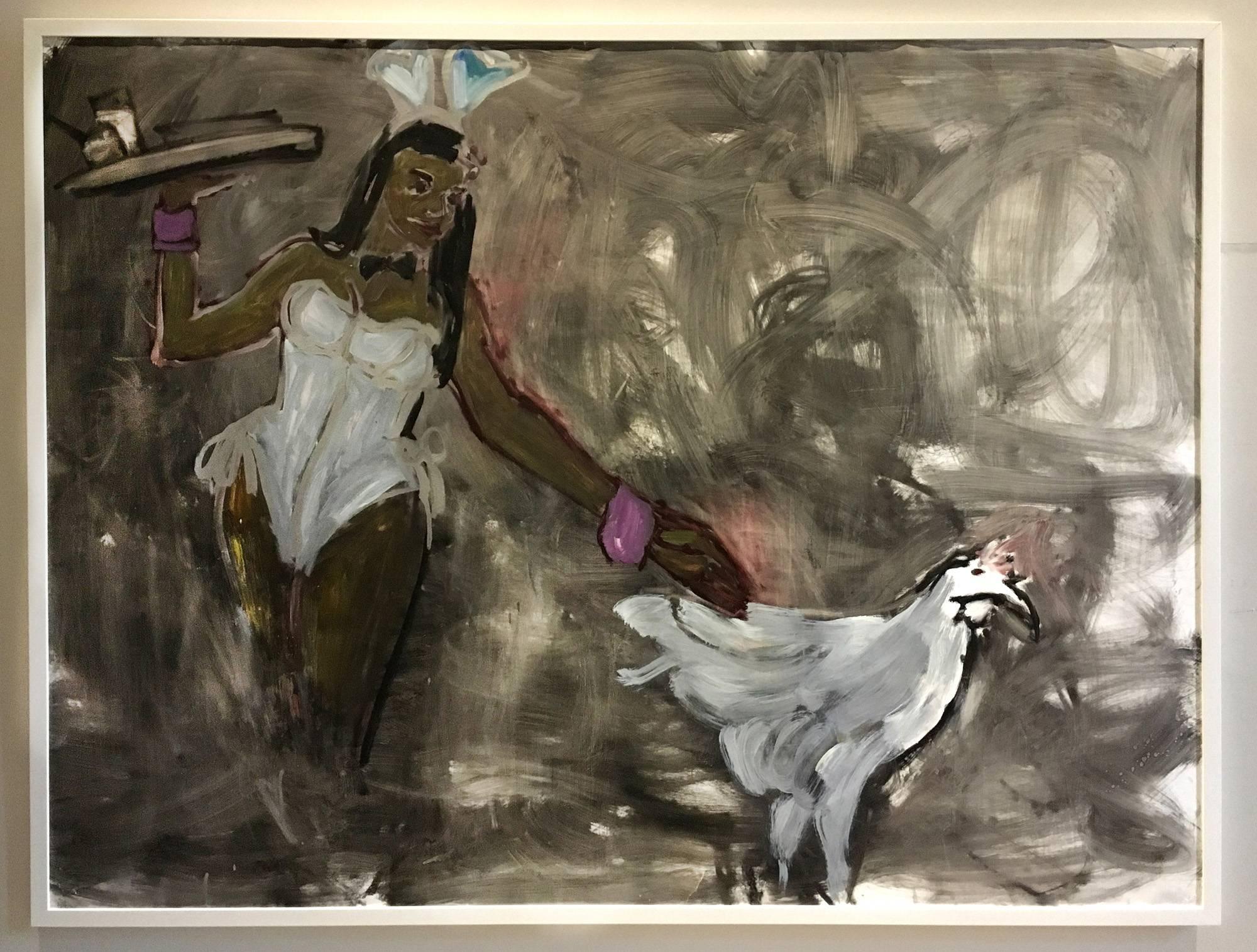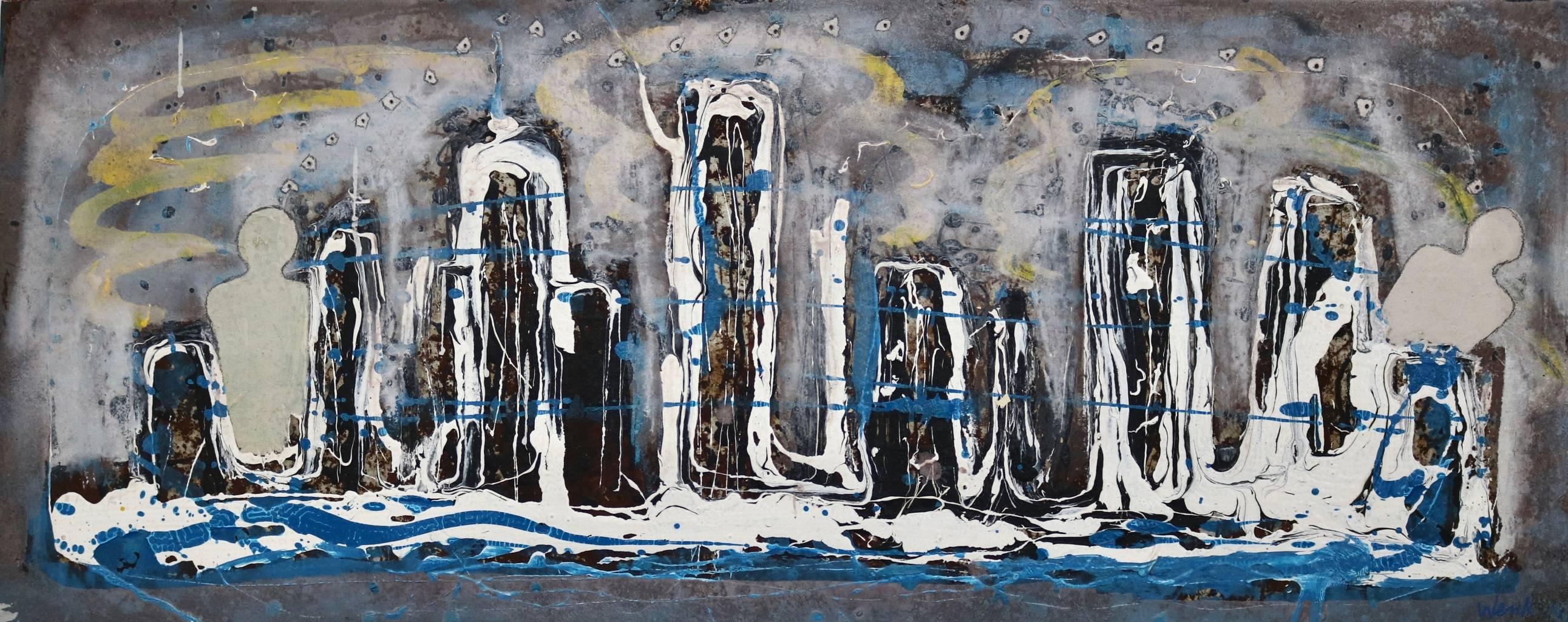Items Similar to Girl & Rooster Enamel Glazed Ceramic Plaque Israeli Artist Awret Naive Folk Art
Want more images or videos?
Request additional images or videos from the seller
1 of 11
Irene AwretGirl & Rooster Enamel Glazed Ceramic Plaque Israeli Artist Awret Naive Folk Art
About the Item
This is a rare ceramic plaque painted with enamel glaze by famed Israeli German artist Irene Awret is signed Awret Safed on the verso. the actual glazed ceramic is 10X15 inches.
Irène Awret was born to a Jewish family in Berlin called Spicker, the youngest of three children. Her mother died in 1927, when Irène was six years old. In 1937 she was forced to stop high school, due to the Nazi race laws. Because she could not continue her regular studies, her father sent her to study drawing, painting and art restoration with a Jewish painter. Among his students were a large number of German Jews who knew they would have to leave Germany within a short time and would require a profession to enable them to support themselves.
When the situation grew worse, following the Kristallnacht (the first major attack on German and Austrian Jews in November 1938), her uncle decided to move to Belgium. In 1939 the situation became even worse - her father was fired from his job and the family were forced to leave their home. As a result, Awret's father tried to send her and her sister to Belgium, with the help of smugglers. The first smuggler proved to be a double agent and they were sent back from Aachen to Berlin. Two weeks later they made a second, successful, attempt to sneak across the border.
Awret worked for a Dutch Jewish family as a maid. As she had her room and board there, she was able to save enough money to study art part-time at Brussels' Académie Royal des Beaux-Arts. A few months later Awret's father joined her and her financial situation became easier. She left her job and studied full-time, helping support herself with restoration work when it was available and by painting portraits to order.
Later, Awret found a hiding place on a farm in Waterloo with a Jewish family who were connected with the underground. In January 1943 she had to return to Brussels, living with a false identity card which stated she was a married woman with two children. Awret succeeded in renting an attic without informing the police where she was - she told her landlady that she had been forced to flee her husband because he beat her. While there, she supported herself by restoring wooden sculptures.
A Jewish informer gave her up to the Gestapo, accompanying the two Gestapo men who arrested her. Awret was able to take a bag containing food and drawing materials. She was detained in the Gestapo cellars in Brussels where she drew. Because there was nothing there to draw, she sketched her own hand (view this work). Awret was interrogated in order to reveal the hiding place of her father who was still in Brussels. The National Socialist regime was determined to persecute him, even though he had fought for Germany in World War I and been permanently disabled. They stepped up their torture and brought Awret before Hartmann, the head of the Gestapo in Brussels. When Hartmann saw her block of drawings, he asked her where she had studied art and halted the interrogation.
Awret was placed in a narrow cell and then transferred to Malines camp, which the Belgian's called Mechelen. Malines was a transit camp to Auschwitz, regularly sending 2000 people at a time. Although she arrived just before Transport No. 20, Irène Awret avoided being included. Instead she was put to work in the leather workshop, decorating broaches. While she was there, Hartmann visited the camp and spotted her: "I could have discovered where your father is hiding," he told her. When her artistic talents became known, she was transferred to the Mahlerstube (artist's workshop) where she worked producing graphics for the Germans until the end of the war. When Carol (Karel) Deutsch (whose works are now on view at Yad Vashem) was sent from Mechelen to his death with his wife, he left young Irene his paintbox. Irene also recalls seeing the great painter Felix Nussbaum and his wife being pushed into a boxcar bound for the gas, and tells of the aftermath of the famous 20th Train incident, when a young Jewish doctor armed only with a pistol and helped by two unarmed friends with a lantern ambushed one of Mechelen's Auschwitz-bound trains carrying 1,618 Jews, most of whom had fled Eastern Europe for Belgium.
Awret's job enabled her to paint and draw - mainly in pencil, but also in watercolors and oils. In the artists' workshop she met a Jewish refugee from Poland - Azriel Awret - who would later become her husband. Among the other artists in the workshop were Herbert von Ledermann-Vütemberg, a sculptor from an aristocratic family with Jewish roots, Léon Landau, and Smilowitz, who perished in the camps in the East. Irène and Azriel tried to bribe a German officer to prevent Smilowitz's deportation. Not only were they unsuccessful, but they were almost put onto the same train. Jacques Ochs was another artist with whom they became friends in the camp. Ochs, a French-born Protestant who lived in Belgium, was interned as a political prisoner. He remained in Belgium after liberation.
After the war the Awrets immigrated to Israel and made their home in Safed. They continued to work, and were instrumental in founding Safed's artists' quarter.
The Beit Lohamei Haghetaot (Ghetto Fighters' House Museum) art collection holds works donated by Awret. These date from her time in Malines camp and from her stay in Brussels after the war, when she was in the company of orphans who had hidden while their parents were sent to Auschwitz. Her highly expressive works have made their way to exhibitions at theTel Aviv Museum, the Haifa Museum of Modern Art and the Modern Art Gallery in Washington, D.C., as well as into the private collections of such individuals as Dr. Jonas Salk, Charlie Chaplin and Joan Fontaine. She wrote an autobiography "They Will Have to Catch Me First." detailing her life during the Holocaust and how art saved her.
Israel has had a Vibrant Folk Art, Naive art scene for a long time now artists like Israel Paldi, Nahum Guttman, Reuven Rubin had naive periods. The most well know of the strict naive artists are Shalom of Safed, David Sharir, Irene Awret, Gabriel Cohen, Natan Heber, Michael Falk and Kopel Gurwin.
- Creator:Irene Awret (1921 - 2014, German)
- Dimensions:Height: 22.5 in (57.15 cm)Width: 17.5 in (44.45 cm)
- Medium:
- Movement & Style:
- Period:
- Condition:wear to frame and matting. piece is in great condition.
- Gallery Location:Surfside, FL
- Reference Number:1stDibs: LU38210631032
About the Seller
4.9
Platinum Seller
These expertly vetted sellers are 1stDibs' most experienced sellers and are rated highest by our customers.
Established in 1995
1stDibs seller since 2014
1,543 sales on 1stDibs
Typical response time: 1 hour
- ShippingRetrieving quote...Ships From: Surfside, FL
- Return PolicyA return for this item may be initiated within 3 days of delivery.
More From This SellerView All
- Girl & Plants Enamel Glazed Ceramic Plaque Israeli Artist Awret Naive Folk ArtBy Irene AwretLocated in Surfside, FLThis is a rare ceramic plaque painted with enamel glaze by famed Israeli German artist Irene Awret (these are generally hand signed Awret Safed on the verso. I just have not opened the frame to check) the actual glazed ceramic is 10.25 X 14.75 inches. It depicts a girl or woman with potted plants, birds, pomegranates and other fruits and flowers in a naif, folk art style. Irène Awret was born to a Jewish family in Berlin called Spicker, the youngest of three children. Her mother died in 1927, when Irène was six years old. In 1937 she was forced to stop high school, due to the Nazi race laws. Because she could not continue her regular studies, her father sent her to study drawing, painting and art restoration with a Jewish painter. Among his students were a large number of German Jews who knew they would have to leave Germany within a short time and would require a profession to enable them to support themselves. When the situation grew worse, following the Kristallnacht (the first major attack on German and Austrian Jews in November 1938), her uncle decided to move to Belgium. In 1939 the situation became even worse - her father was fired from his job and the family were forced to leave their home. As a result, Awret's father tried to send her and her sister to Belgium, with the help of smugglers. The first smuggler proved to be a double agent and they were sent back from Aachen to Berlin. Two weeks later they made a second, successful, attempt to sneak across the border. Awret worked for a Dutch Jewish family as a maid. As she had her room and board there, she was able to save enough money to study art part-time at Brussels' Académie Royal des Beaux-Arts. A few months later Awret's father joined her and her financial situation became easier. She left her job and studied full-time, helping support herself with restoration work when it was available and by painting portraits to order. Later, Awret found a hiding place on a farm in Waterloo with a Jewish family who were connected with the underground. In January 1943 she had to return to Brussels, living with a false identity card which stated she was a married woman with two children. Awret succeeded in renting an attic without informing the police where she was - she told her landlady that she had been forced to flee her husband because he beat her. While there, she supported herself by restoring wooden sculptures. A Jewish informer gave her up to the Gestapo, accompanying the two Gestapo men who arrested her. Awret was able to take a bag containing food and drawing materials. She was detained in the Gestapo cellars in Brussels where she drew. Because there was nothing there to draw, she sketched her own hand (view this work). Awret was interrogated in order to reveal the hiding place of her father who was still in Brussels. The National Socialist regime was determined to persecute him, even though he had fought for Germany in World War I and been permanently disabled. They stepped up their torture and brought Awret before Hartmann, the head of the Gestapo in Brussels. When Hartmann saw her block of drawings, he asked her where she had studied art and halted the interrogation. Awret was placed in a narrow cell and then transferred to Malines camp, which the Belgian's called Mechelen. Malines was a transit camp to Auschwitz, regularly sending 2000 people at a time. Although she arrived just before Transport No. 20, Irène Awret avoided being included. Instead she was put to work in the leather workshop, decorating broaches. While she was there, Hartmann visited the camp and spotted her: "I could have discovered where your father is hiding," he told her. When her artistic talents became known, she was transferred to the Mahlerstube (artist's workshop) where she worked producing graphics for the Germans until the end of the war. When Carol (Karel) Deutsch (whose works are now on view at Yad Vashem) was sent from Mechelen to his death with his wife, he left young Irene his paintbox. Irene also recalls seeing the great painter Felix Nussbaum and his wife being pushed into a boxcar bound for the gas, and tells of the aftermath of the famous 20th Train incident, when a young Jewish doctor armed only with a pistol and helped by two unarmed friends with a lantern ambushed one of Mechelen's Auschwitz-bound trains carrying 1,618 Jews, most of whom had fled Eastern Europe for Belgium. Awret's job enabled her to paint and draw - mainly in pencil, but also in watercolors and oils. In the artists' workshop she met a Jewish refugee from Poland - Azriel Awret - who would later become her husband. Among the other artists in the workshop were Herbert von Ledermann-Vütemberg, a sculptor from an aristocratic family with Jewish roots, Léon Landau, and Smilowitz, who perished in the camps in the East. Irène and Azriel tried to bribe a German officer to prevent Smilowitz's deportation. Not only were they unsuccessful, but they were almost put onto the same train. Jacques Ochs was another artist with whom they became friends in the camp. Ochs, a French-born Protestant who lived in Belgium, was interned as a political prisoner. He remained in Belgium after liberation. After the war the Awrets immigrated to Israel and made their home in Safed. They continued to work, and were instrumental in founding Safed's artists' quarter. The Beit Lohamei Haghetaot (Ghetto Fighters' House Museum) art collection holds works donated by Awret. These date from her time in Malines camp and from her stay in Brussels after the war, when she was in the company of orphans who had hidden while their parents were sent to Auschwitz. Her highly expressive works have made their way to exhibitions at theTel Aviv Museum, the Haifa Museum of Modern Art and the Modern Art Gallery in Washington, D.C., as well as into the private collections of such individuals as Dr. Jonas Salk...Category
1950s Expressionist Figurative Paintings
MaterialsEnamel
- Venice Italy Landscape Gouache Painting Canal with Gondolier Bridge of SighsLocated in Surfside, FLVita P. Solomon Born December 16, 1916 in Philadelphia, PA to Harry Petrosky and Rose Bobrow, Vita graduated from Overbrook High School in 1933 and earned her diploma in Illustration and won the Lewis European Fellowship in 1937 from Moore College of Art. While raising a family she earned a Bachelor of Fine Arts, with Honors, as well as a Bachelor of Science in Education, with Honors, from Temple University Tyler School of Fine Art in 1958, and a Master of Fine Arts from Tyler in 1960. She was commissioned to paint official oil portraits of such notable Pennsylvanians as George Leader, Governor of Pennsylvania (1955-1959); Alfred Williams, Dean of the Wharton School...Category
Mid-20th Century Expressionist Landscape Paintings
MaterialsGouache
- Gouache Painting Jules Pascin Hand Signed Woman in Boudoir German ExpressionismBy Jules PascinLocated in Surfside, FLGenre: German Expressionist Subject: Woman Medium: gouache paint Surface: Paper board This is hand signed lower right. Framed it measures 17.25 X 15.5, sheet 12 X 10 This came from a Jewish estate. there was no additional paperwork or provenance. Julius Mordecai Pincas (March 31, 1885 – June 5, 1930), known as Pascin Jules...Category
Early 20th Century Expressionist Figurative Paintings
MaterialsPaper, Cardboard, Gouache
- Shuk Machane Yehuda Jerusalem Market Israeli Oil PaintingLocated in Surfside, FLsimilar in style to David Azuz a new Expressionist Israeli market scene possibly by Roz Rice.Category
1970s Expressionist Figurative Paintings
MaterialsCanvas, Oil
- Israeli Judaica Rabbi Expressionist Gouachel PaintingBy Adolf AdlerLocated in Surfside, FLsize includes frame Adolf Adler 1917 - 1996 Adolf Adi Adler was born in Romania in 1917. Attended the Art College of Kluj Romania in 1950. (in Satu Mare, original home city of the Satmar Hasidic group). In 1963, Adler was chief among a group of well known artists who immigrated to Israel. He was awarded the Nordau prize in 1978. He works have been auctioned at Sloan's Auction House in Maryland and Karrenbauer Auction House in Germany and today are represented in the Yad Vashem Holocaust Museum in Jerusalem. In 1984, a retrospective of his work was held in Rishon Le Zion. He died in 1996. Awards and Prizes 1993 Mordecai Ish-Shalom Prize, Artists House...Category
Mid-20th Century Expressionist Figurative Paintings
MaterialsPaper, Gouache
- French Modernist LANDSCAPE WITH HOUSES School of Paris Oil PaintingBy Isis KischkaLocated in Surfside, FL"School of Paris" Isis Kischka was born in Paris on the 26 October 1908 to a Polish Jewish family who had migrated from the Ukraine two years earlier. After completing studies in c...Category
20th Century Expressionist Figurative Paintings
MaterialsCanvas, Oil
You May Also Like
- "Figura Danzante" by Enzio Wenk, 2018 -Acrylic, Enamel, Figurative ExpressionismBy Enzio WenkLocated in Bresso, ITTranslated title: "Dancing figure". Acrylic paint and enamel on canvas. The artist sells the handmade, original and one-of-a-kind piece, but he reserves the right to duplicate it...Category
2010s Expressionist Figurative Paintings
MaterialsEnamel
- Girl In A Blue ChairBy Wyona DiskinLocated in Aramits, Nouvelle-AquitaineWyona Diskin, American (1915 - 1991) Girl In A Blue Chair Acrylic on canvas partially painted over wire mesh, Unsigned. Framed. Measurements: H 70.5 x W 49.5 x D 1.25 inches Wyona ...Category
1970s Expressionist Figurative Paintings
MaterialsWire
- Strongman and Fire eater circus, coney island influences colorful carnivalBy Stephen BassoLocated in Brooklyn, NYOil on board mounted on a wooden frame suitable for immediate hanging. The board has been primed with an acrylic pumice gel giving the surface a rough texture visible from the photo...Category
2010s Expressionist Figurative Paintings
MaterialsBrass
- Beauties Series: Beauty and the BirdBy Jackie FelixLocated in Buffalo, NYAn original acrylic on paper expressionist painting by American contemporary female artist Jackie Felix. This painting from Felix's Beauty Series was exhibited in the artist's solo ...Category
1980s Expressionist Figurative Paintings
MaterialsSilver Leaf
- "Il motivo di un viaggio" by Enzio Wenk, 2006- Acrylic on Metal, Urban LandscapeBy Enzio WenkLocated in Bresso, ITTranslated title: "The reason for a trip" Acrylic on metal plate.Category
Early 2000s Expressionist Landscape Paintings
MaterialsMetal
- Gerhard Cohn Roemers German 1900-1965 Venice Ponte Del Rialto Italy Oil PaintingBy Gerhard Cohn RoemersLocated in Meinisberg, CHGerhard Cohn Roemers (German, 1900 - 1965) Venice - Ponte Del Rialto • Oil on canvas, ca. 40 x 65 cm • Frame, ca. 57 x 82 cm • Signed and titled lower right corner Worldwide shipp...Category
Mid-20th Century Expressionist Landscape Paintings
MaterialsCanvas, Oil
